If you have a knack for taking things apart and figuring out how to put them back together, a career as an electrician may be the perfect fit for you. You also need excellent problem-solving skills to overcome challenges on the job.

Electrical contractors must follow strict regulations and safety procedures when working in homes or commercial buildings. This requires a detail-oriented mindset that ensures all work is up to code. Call Us Today for more information.
Whether you’re learning to be an electrician or just have a passion for DIY projects, it’s important to understand how electrical diagrams work. Electrical schematics use standardized symbols to represent wires, bulbs, switches and other components in an electrical circuit. The standardized diagrams make it easier for technicians to read and understand complex electrical systems.
Wiring diagrams can be incredibly detailed, depending on the type of diagram. For example, a pictorial diagram will often have photographs of actual wire connections, which can help people who aren’t familiar with electrical symbols understand the schematic. Other types of wiring diagrams may be more abstract, focusing on connections between components rather than their physical appearance.
The most common electrical wiring diagram is the house wiring diagram, which shows all of the electrical connections in a home. These connections include the receptacles, lighting and other major electrical devices in a house, as well as the connections between them. A house wiring diagram will typically include a schematic of the entire home, as well as detailed wiring diagrams for specific rooms and fixtures.
Other types of electrical wiring diagrams include circuit diagrams, which are used by technicians to troubleshoot and repair complex electrical systems. These types of diagrams are usually more complicated than the simple ones found in a house wiring diagram, and they will feature more schematic symbols to represent parts like diodes, relays, controlled switches, capacitors and logic gates.
Finally, there are ladder diagrams, which are used to show the connections between electrical circuits. These types of diagrams will use a series of horizontal lines to represent different circuits in the system, with each line representing one component. The vertical power lines will be labeled with numbers like L1, L2, etc., and the horizontal lines will be labeled with a number that corresponds to the circuit’s position in the system.
While all of these types of electrical wiring diagrams can be useful, it’s important to know which type to use for each situation. If you are installing a new receptacle, for instance, you’ll want to use a wiring diagram that includes a picture or a line drawing of the receptacle and its connection points. This will help ensure that you connect the wires properly, so that they don’t cause a fire hazard or other problems.
Wire Gauge
When choosing wire for an electrical circuit, one of the most important factors is the gauge. Thicker gauges offer higher amperage levels and are better suited to handling heavy-duty circuits than thinner gauges, which can cause overheating and even fires. Choosing the right gauge for a circuit depends on a number of factors, including how much amperage it will carry, the length of the run and the type of load.
In the United States, there are 44 standardized wire sizes defined by American Wire Gauge (AWG) or Brown & Sharpe Gage. These are the standard wires that most electricians will work with. The AWG system uses whole numbers to represent the size of a solid-round conductor, rather than fractional inches. The gauge sizes are spaced 26% apart, with the lowest sizes at the top of the range.
The AWG system defines a number of different wire diameters and physical properties, but the most critical property is the current carrying capacity. The chart above shows the maximum amps a given wire can handle, along with its thickness and other physical characteristics.
Master electrician Heath Eastman explains the importance of selecting the correct wire gauge and how to choose the right gauge for each project. He also discusses the benefits of working with UL-rated wire, which is wire that has been tested for safety.
A common myth is that higher AWG numbers equal smaller wires, but this is not the case. The physical wire size is inversely proportional to the gauge number, because of the amount of processing it takes to manufacture each size. For example, the AWG number of a 20-gauge wire is greater than that of a 9-gauge wire because it requires more drawing operations to create the thicker wire. In addition to the AWG number, wires are typically characterized by their circular mil or MCM size as well. This is a measurement of the wire’s cross-sectional area, and is more precise than diameter because it accounts for a portion of the total wire’s surface area. A free online calculator can convert MCM to diameter and gauge for any wire size.
Wire Colors
When it comes to electrical wiring, the colors of wires tell you a lot about their purpose. This is particularly true if you are a homeowner who wants to work on light switches, electric outlets, or other electrical projects around the home. Whether you are a DIY-er or a professional electrician, understanding the meaning of electrical wire color codes is essential to safety and proper wiring technique.
Generally speaking, black indicates a hot or live wire that is carrying current. This is typically the wire that runs from the breaker box to electrical devices like light switches and wall outlets. Sometimes, it may have a red stripe or tape on the sheathing. This is used for a second hot wire in 220-volt circuits and is often the switch leg connection between two hardwired smoke detectors.
White wires indicate neutral or ground wires, but this is not always the case. If a white wire is marked with black or has red tape on the sheathing, it is being used as a hot wire. It is also possible to have a third hot wire in a cable (although this is uncommon). Green and yellow indicate protective or ground wires that run from the outlet or light fixture to the ground bus bar in the electrical panel.
While electrical wiring is relatively safe when properly installed and maintained, there are still a number of accidents each year that result in death or injury. In addition to these fatalities, many of the accidents that happen involve non-fatal shocks. These are caused by improper handling of electrical wires and equipment, so it is important to understand the wire color code system and use it in conjunction with a multimeter or other non-contact voltage tester before working on any power conductor.
In addition to knowing the meaning of electrical wire colors, it is always important to shut off power to any outlet or switch before beginning work. It is also important to assume that all electrical wires are carrying current, so you should always work on them in dry conditions. If you are not comfortable working with electrical wiring, please call a professional electrician in your area for assistance.
Wire Terminations
Whether it’s soldered, crimped or using connectors like terminals and wire nuts, electrical terminations are the connection points between a cable and a device. It’s important to properly terminate cables because it allows you to transmit signals and power effectively while also protecting them from damage or interference.
When performing a wire termination, it’s important to understand the different methods and their respective benefits and drawbacks. Some common ways to connect wires include crimping, which involves compressing a metal sleeve around the cable, and soldering, which uses melted solder to secure the conductors. Crimping is the most popular method of termination because it’s fast, clean and mechanically strong. Soldering, on the other hand, can be more time-consuming and requires specific skill to avoid mistakes.
Some other types of electrical terminations include screw terminals, which secure a wire by tightening a built-in screw on the connection-side opening, and insulation displacement connectors (IDC), which pierce the wire’s insulation to create a contact with the copper conductor underneath. Screw terminals are ideal for use with thin-gauge wires, while IDC terminal blocks and modules are more suitable for thicker-gauge wiring.
Other types of electrical connections include ring terminals, spade or fork terminals, and ferrule terminals. Ring terminals are one of the most common types of connectors, primarily because they offer a firm connection with zero chance of disconnection at the stud. They’re also a good choice for busbars, terminal blocks, and feed-through-connectors.
Another type of electrical connector is the wire nut, which has internal threads that twist around the stripped wire ends to secure them. When installing wire nuts, it’s important to remember that you must always wrap each bare wire end with electrical tape before connecting them to anything. This helps prevent accidental short circuits that can cause fires. It’s also important to ensure that the wire nut is properly seated on the wire, otherwise it could fail or become loose. It’s recommended that you wear rubber gloves when handling any type of electrical terminal. This will help prevent injuries and skin burns, and it’ll keep your hands safe from sharp edges.

